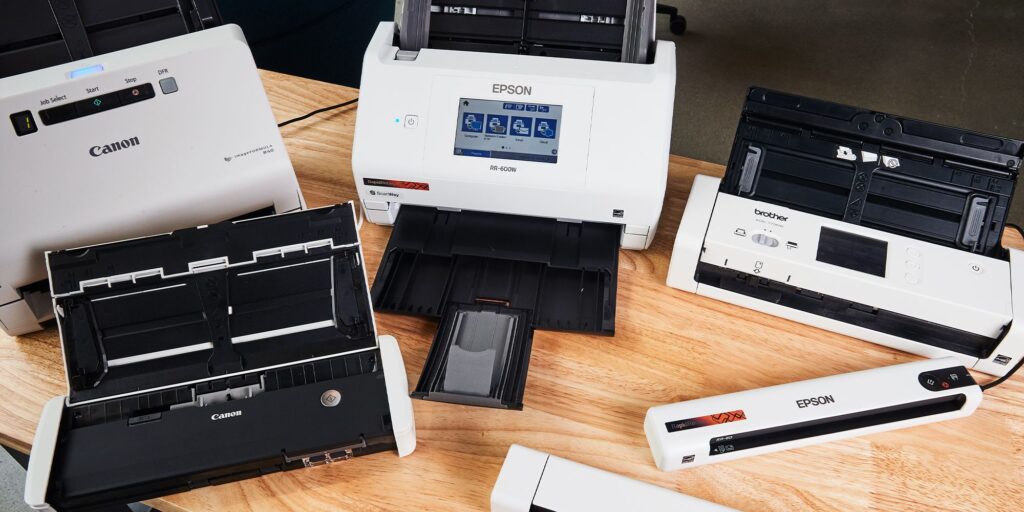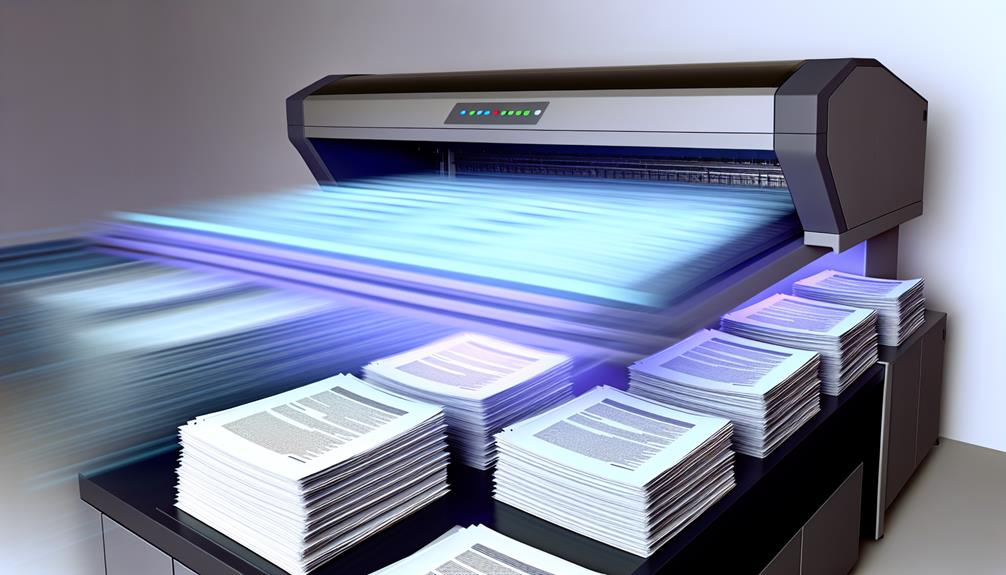Are you tired of spending hours scanning stacks of documents one by one? Well, imagine a high-volume document scanner that can effortlessly handle up to 100 pages per minute, saving you valuable time and energy.
In this discussion, we will explore the world of high-volume document scanners and provide you with valuable insights on the types of scanners available, key features to consider, the benefits they offer, tips for choosing the right scanner, and best practices for efficient document scanning.
Get ready to revolutionize your scanning process and discover a whole new level of productivity!
Types of High-Volume Document Scanners

There are several types of high volume document scanner available on the market today. When choosing a scanner for high-volume scanning, two important factors to consider are scanning speed and cost-effectiveness.
In terms of scanning speed, there are scanners that can process hundreds of pages per minute. These high-speed scanners are ideal for businesses that require quick and efficient scanning of large volumes of documents. They can handle high workloads and ensure productivity without compromising on quality.
When it comes to cost-effective options, there are scanners available at various price points to suit different budgets. Some scanners offer advanced features like automatic document feeders, duplex scanning, and image enhancement capabilities. These features not only improve scanning efficiency but also help save time and resources.
Additionally, some high-volume document scanners come with software that enables seamless integration with existing systems and workflows. This integration helps streamline document management processes, reducing manual intervention and improving overall efficiency.
Key Features to Consider
Consider these key features when selecting a high-volume document scanner.
One important factor to consider is the document scanner price range. Determine your budget and choose a scanner that offers the best value for your money. Look for a scanner that meets your specific needs without breaking the bank.
Another crucial aspect to consider is the maintenance requirements of the scanner. Find out how often the scanner needs to be serviced and what maintenance tasks are required. Look for a scanner that has minimal maintenance requirements to save time and money in the long run.
In addition to price range and maintenance requirements, there are other key features to consider when selecting a high-volume document scanner.
Look for a scanner with high scanning speeds to ensure efficient and timely document processing. Consider the scanner’s duty cycle, which refers to the number of pages the scanner can handle per day or month. A higher duty cycle is ideal for high-volume scanning needs.
Another important feature is the scanner’s document feeder capacity, as it determines how many documents can be loaded at once for scanning. Look for a scanner with a large document feeder capacity to improve productivity.
Benefits of Using High-Volume Scanners

Using high-volume scanners offers numerous benefits that can greatly enhance document processing efficiency. One of the key benefits is efficiency improvements. High-volume scanners are designed to handle large volumes of documents quickly and accurately. They have high-speed scanning capabilities and advanced features such as automatic document feeding and double-sided scanning. These features allow for faster and more efficient scanning, reducing the time and effort required for document processing.
Another significant benefit of using high-volume scanners is cost savings. By automating the scanning process and minimizing manual intervention, high-volume scanners can significantly reduce labor costs. They eliminate the need for manual sorting, feeding, and scanning of documents, allowing employees to focus on more important tasks.
Additionally, high-volume scanners can help save on storage costs by converting physical documents into digital files that can be easily stored and accessed electronically.
Tips for Choosing the Right Scanner
To choose the right scanner, focus on your specific document processing needs and consider key factors such as scanning speed, document size compatibility, and connectivity options.
First, determine the volume and type of documents you’ll be scanning. If you have a high volume of documents, look for a scanner with a high scanning speed to ensure efficient processing.
Additionally, consider the size of the documents you’ll be scanning. Make sure the scanner can handle the document sizes you typically work with.
Connectivity options are also crucial, as they determine how the scanner will integrate with your existing systems. Look for scanners that offer USB, Ethernet, or wireless connectivity options for seamless integration.
When considering scanner prices, remember that higher-end scanners tend to offer more features and better performance, but they may also come with a higher price tag.
Lastly, don’t forget to consider scanner maintenance. Look for scanners that come with reliable customer support and warranty options to ensure that any technical issues can be resolved quickly.
Best Practices for Document Scanning

For optimal document scanning, ensure that your scanner settings are properly configured and that you’re using the appropriate file format. These best practices will help you optimize your scanning workflow and ensure high-quality scans.
First, adjust your scanner settings to match the type and size of documents you’re scanning. Set the resolution to a level that provides sufficient clarity without creating unnecessarily large file sizes. Additionally, adjust the brightness and contrast settings to enhance legibility and ensure that text and images are accurately captured.
Next, choose the appropriate file format for your scanned documents. PDF is the most commonly used format for scanned documents as it preserves the layout and formatting of the original file. It’s also compatible with most devices and easy to share. However, if you need to edit the scanned documents, consider using an editable file format such as Word or Excel.
To further optimize your scanning workflow, organize your documents before scanning. Remove any staples, paper clips, or sticky notes that may hinder the scanning process. Straighten any curled or creased pages to ensure smooth feeding through the scanner.
Frequently Asked Questions
What Is the Average Cost of a High-Volume Document Scanner?
The average cost of a high-volume document scanner depends on factors such as brand, features, and capabilities. Comparing prices from different brands can give you a better idea of the price range.
Are High-Volume Document Scanners Compatible With Different Operating Systems?
High-volume document scanners are compatible with different operating systems, but there may be compatibility challenges. Despite this, the benefits of using high-volume scanners, such as increased efficiency and productivity, make them worth considering.
Can High-Volume Document Scanners Handle Different Paper Sizes and Types?
High-volume document scanners can handle various paper sizes and types, making them versatile for any office. With scanning speeds up to 100 pages per minute, you’ll be able to efficiently digitize all your documents.
Is It Possible to Integrate High-Volume Document Scanners With Existing Document Management Systems?
Yes, you can integrate high-volume document scanners with your existing document management systems. This integration brings numerous benefits, such as improved efficiency, streamlined workflow, and easy access to digitized documents.
What Kind of Technical Support Is Available for High-Volume Document Scanners?
Need technical support for your high-volume document scanner? Troubleshooting tips for common issues and regular maintenance are crucial. Rest assured, assistance is available to keep your scanner running smoothly.
